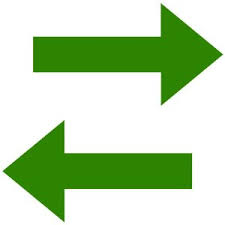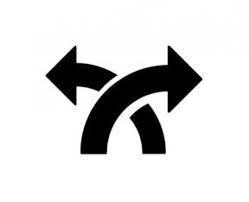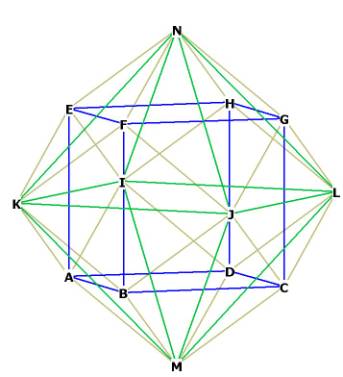|
(2019
midterm assignment) Model Midterm answers 2019 (Index) Essay 1: Compare, contrast, and evaluate Narratives of the Future |
 |
Kimberly Berlin
The Ouroboros Future
Humanity is a flame, and the light that
penetrates the darkness is made up of stories. In her book,
Illuminating the Prophecy, author
Maggie Stiefvater writes, “... Humans everywhere feel compelled to fold and
carve structure events into a narrative -- we’ve been doing it for as long as
we’ve been around. We mutter cautionary tales to remind others what frightens
us, whisper love stories to give form to our hope, and shout heroic epics to
underline what we believe in.” Good stories often involve remembering events of
the past, analyzing the present moment, and speculating about the future to
come. There exist three narrative models that categorize the types of stories we
tell. These are: Apocalypse, Evolution, and Alternative.
The Apocalypse narrative involves a linear
representation of time, with a beginning, middle, and end. Perhaps the most
recognizable example of an Apocalyptic narrative is the Christian Bible. In the
book of Genesis, God creates the heaven and the earth. It very clearly states
that this is the beginning of the story of mankind. God creates the universe and
everything that exists within it. Throughout Genesis and the next 64 books, the
Bible describes the history of the Jewish people and the early Christian church
over an estimated period of around 4,000 years (for further study:
Anno Mundi and the Hebrew calendar).
It places heavy significance on human relations and even goes so far as to
describe the Creator of the universe becoming a man and living among us, in
order to experience the human struggle and teach us how to live in relation to
one another. Jesus of Nazareth
embodies the Romantic hero, the knight in
shining armor who came to sacrifice himself to save the world. Many prophetic
books fill the pages of the Bible, the most prominent of which are the books of
Daniel, Isaiah, and Revelation. This final book, also known as the Apocalypse of
John (for further study: Apocalypses of Paul and Peter, etc.), begins in
epistolary form and ends in prophetic form, describing events that lead up to
the end of the world and the victory of the Creator over those angels and humans
who refused to subject themselves to His rule.
This narrative model, being predominantly literary in nature, is brimming with
symbolism. Before the creation of the world, in the midst of darkness and void,
there existed water. “ (1) … And the Spirit of God moved upon the face of the
waters. … (6) And God said, let there be a firmament in the midst of the waters
and let it divide the waters from the waters. (7) And God made the firmament,
and divided the waters which were under the firmament from the waters which were
above the firmament: and it was so. (8) And God called the firmament Heaven.”
Water is the first real thing to exist, and from the water springs land,
vegetation, animals, and ultimately mankind (This progression is consistent with
the theories of human evolution). Later in Genesis, however, God uses a flood to
wipe the earth clean of its human stain and start over again with Noah and his
family. Although this event is catastrophic and apocalyptic, it still functions
as a rebirth, since life on earth was not completely destroyed. During the
Apocalypse, God once again will try to destroy the earth -- this time with fire.
According to Malachi 4:1, “The day is coming, burning like an oven, when all the
arrogant and all evildoers will be stubble. The day that is coming shall set
them ablaze, says the LORD of hosts, so that it will leave them neither root nor
branch.” 2 Peter 3:10 describes a similar scene: “But the day of the Lord will
come like a thief, and then the heavens will pass away with a roar, and the
heavenly bodies will be burned up and dissolved, and the earth and the works
that are done on it will be exposed.”
Whereas in the Apocalypse narrative, water symbolizes
life and fire death, in the Evolution narrative, both elements symbolize both
life and death. Water and heat are both necessary ingredients for continued
living but polluted water will poison and fire will burn. In Octavia Butler’s
Parable of the Sower, good water is
something Lauren and the other travelers are constantly on the lookout for. When
she, Zahra, and Harry reach the ocean and Lauren digs a hole in the sand to
collect filtered water, Harry says, “Look at the people in this damned place! Do
you see any bathrooms? What do you think they do out here. You ought to at least
have the sense to use a water purification tablet!” (p. 206). They are all aware
that this water, which is so vital to their survival, could easily kill them if
it happened to carry the wrong bacteria. Still, they need to drink, or else they
will die of thirst -- an extremely slow and painful way to go.
Just as dangerous, however, is fire. Although a required element to cook their
food (which could also carry deadly bacteria if not prepared correctly), fire is
present throughout the book as a symbol of death and destruction. Throughout
their journey, they encounter a number of burned communities, and the threat of
the “pyro” junkies finding them and setting them ablaze, too, constantly looms
over them. At one point, a great fire spreads, following the group along the
highway and eventually overcoming them. Butler writes, “ At some point in the
endless night, more smoke and ash than ever began to swirl around us, and I
caught myself thinking that we might not make it. Without stopping, we wet
shirts, scarves, whatever we had, and tied them around our noses and mouths. The
fire roared and thundered its way past us on the north, singeing our hair and
clothing, making breathing a terrible effort. … I thought we would die. I
believed there was no way for us to survive this sea of fire, hot wind, smoke
and ash. I saw people -- strangers -- fall, and we left them lying on the
highway, waiting to burn. I stopped looking back” (p. 308).
Parable
of the Sower is an example of an Evolution narrative. This model deals with
the story of the cosmic universe as opposed to humanity. Stories that follow
this narrative embody the possibility of progress, continued change down through
the generations. Surviving means passing on knowledge and creating a stronger
legacy. Although the Big Bang theory suggests a beginning to the universe and
the Heat Death theory suggests an end, the focus of Evolutionary narratives
falls more on the cycle of change from one generation to the next. From the
start, Lauren knows society is collapsing. She makes it her mission to survive
and found a new society through a new religion. Acorn, the settlement they
decide to create, symbolizes new growth, strength over time, and prosperity.
Just as burning a field before planting prepares the land to host new growth,
the fires that uprooted the travelers from their homes and swept over Bankole’s
property, killing his family, prepared the land to host new vegetation and new
families. As one generation ends, another begins.
The Alternative narrative deals more with
possibilities and consequences than predetermined, linear time or the cycles of
life and death. Often described as a branching tree, a maze, or a forking path,
the Alternative narrative focuses on what could be -- or what might have been.
These stories often involve space and/or time travel and alternate histories/
speculative futures. The Time Machine,
by H.G. Wells, deals with time travel into the deep future and features an
inquisitive and empirical Time Traveler, who desires to push the boundaries of
human limitations: “Upon that machine, … I intend to explore time” (p. 12). As
the Time Traveler makes his way through the centuries, he passes countless
permutations of human generations until at last arriving in a time when the
human race has split off into two distinctive sub-races: the Eloi and the
Morlocks. Going further into the future, the Time Traveler encountered giant
crabs and, going even further, a black shape with tentacles. What is the
probability that the final dregs of life upon the dying earth would be, of all
things, a small, black creature seemingly without intelligence or wit? In the
dull glow of the dying sun and in the midst of the blood-red ocean, in the chill
that hung in the thin, unbreathable air, what are the odds that humanity might
have survived -- intact and recognizable? These are questions that beg the
possibility of another future. The Alternative narrative, although playful and
explorative, often finds itself face-to-face with existential crises. At what
point does a man cease to be human? Can tragedy of death be avoided, or is our
fate sealed? Are there any other options? The short answer: we don’t know.
Clark Omo wrote in his 2017 midterm, “Both
narratives [Apocalypse and Evolution], interestingly, coincide on a single
point: they both promote an anxiety toward what lies ahead. This point is the
driving force of both narratives, as it serves as the vector through which the
readers can explore the possibilities, both optimistic and frightening, that lie
ahead” (The Future Duo: The Links Between the Two Narratives). One might argue
that the Alternative narrative -- the “what if?” scenario -- also explores
optimistic and/or frightening possibilities of the future. After all, does
anyone really know where we’re headed? As the Time Traveler pointed out, “Time
is only a kind of Space. … We are always getting away from the present moment.
Our mental existences, which are immaterial and have no dimensions, are passing
along the Time-Dimension with a uniform velocity from the cradle to the grave.
Just as we should travel down if we
began our existence fifty miles above the earth’s surface” (p. 4-5). According
to his logic, if the present moment is a point on the coordinate plane, it
should draw a line as it progresses forward through time. An Apocalypse
narrative would have the line beginning at one point and ending at another, with
no overlaps or breaks. An Evolution narrative involves the cycle of improvement
through the choice decisions and subsequent death of a generation, leading to
another generation that does the same, and so on. The line would be drawn as a
circle, which is said to be an infinitely-long line. It may be concluded that,
as the present makes its way around the circle, it gains magnitude with the
progress of each evolutionary adaptation and becomes a vector, growing ever more
complex with each iteration of the cycle, each permutation of the story. In this
way, the combination of the three narrative models is shown to be an Ouroboros
-- the serpent that eats its own tail and creates Life out of Death, Creation
out of Apocalypse. Where one story ends, another one begins. And how different
that new story might be!
 |
 |
 |
